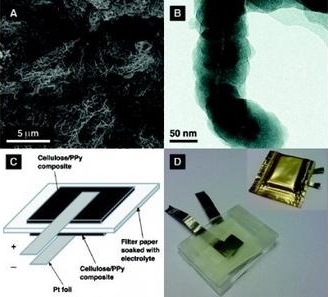
Inhabitat: Algae is often touted as the next big thing in biofuels, but the slimy stuff could also be the key to paper-thin biodegradable batteries according to researchers at Uppsala University in Sweden. Eventually, the bio batteries could compete with commercial lithium-ion batteries.
Conducting polymers have long been thought to be a solution in developing lightweight, flexible, nonmetal batteries. But up until now, these polymers have had been impractical because regular paper can’t hold enough of them work effectively. Now Uppsala researcher Maria Stromme and her team has found that the smelly algae species that clumps on beaches, known as Cladophora, can also be used to make a type of cellulose that has 100 times the surface area of cellulose found in paper. That means it can hold enough conducting polymers to effectively recharge and hold electricity for long amounts of time.
The algae-based paper sheet batteries hold up to 200% more charge than regular paper-based cellulose batteries, and they can recharge in as little as 11 seconds. Eventually, they could be used in any application that requires flexible electronics — for example, clothing or packaging that lights up. Perhaps most importantly, the algae batteries could one day cut down on e-waste from conventional metal batteries.
Algae Could Be the Key to Ultra-Thin Biodegradable Batteries [Inhabitat]
Algae-ion Batteries
(Visited 7 times, 1 visits today)